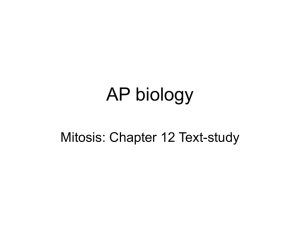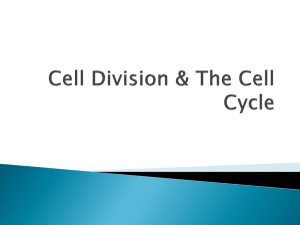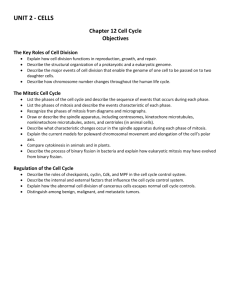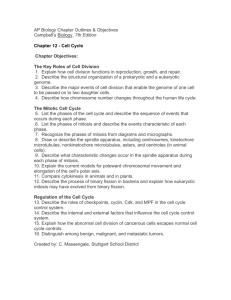The Cell Cycle October 12, 2005
advertisement
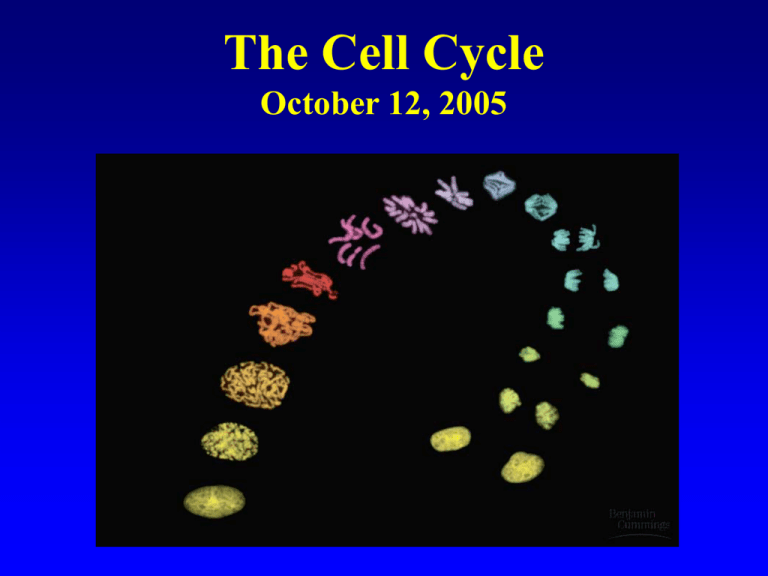
The Cell Cycle October 12, 2005 Cell Division Functions in Reproduction, Growth, and Repair Important Terms (part one) Genome = all of a cell’s DNA Chromosome = individual DNA molecule Chromatin = chromosomal DNA and its protein scaffold Sister chromatids = the two identical copies of a duplicated chromosome Centromere = the point of attachment for two sister chromatids Somatic cells = (most cells) have two copies of each chromosome (diploid) Gametes = (reproductive cells; sperm and eggs) have one copy of each chromosome (haploid) More Important Terms Cell cycle = the ordered sequences of events involving cell division Interphase = the main part of the cell cycle: G1 phase - cell prepares for DNA synthesis, usually grows in size S phase - DNA is duplicated G2 phase - cell checks fidelity of DNA replication, prepares for nuclear division Mitosis (M phase) = nuclear division Mitosis subphases - prophase, prometaphase, metaphase, anaphase, telophase Cytokinesis = division of cytoplasm Mitosis (1) Mitosis (2) The Mitotic Spindle The mitotic spindle is composed of microtubules, and directs the alignment of chromosomes on the metaphase plate. During anaphase, the microtubules attached to each centromere to guide the movement of chromosomes toward spindle poles. Polar Depolymerization of Microtubules and Movement of NonKinetochore Microtubules Cytoplasmic Division Microfilaments contract to divide the cytoplasm. Plant cells are less flexible, because of the cell wall, and deposit cell wall material between the two daughter cells. Mitosis (differential staining) Mitosis in Growing Tissue Binary Fission in Bacteria Evolution of Mitosis Cell Cycle Control A growth signal leads to passage through the G0 restriction point into G1. The cell then executes a programmed series of steps that culminate in mitosis and cytokinesis. The cell’s place in the cell cycle is signaled by the presence or absence of cell cycle kinases. MPF is an example of kinase control of the cell cycle. It is like a license that allows the cell to begin M phase of the cell cycle. MPF is a two-subunit enzyme. One subunit is Cdk (present during the whole cell cycle). The other subunit is a cyclin protein that builds up as M phase approaches. When the cyclin concentration is high enough, cyclin binds to Cdk, forming the MPF enzyme. MPF activity signals the start of mitosis. Cancer Normal cells are transformed to tumor cells when cell division is not controlled. Cancer cells are growth-factor independent. Cancer cells have escaped density-dependent inhibition. Most cancerous cells are destroyed by the immune system, but some cells progress from benign to malignant, and possibly to metastatic. Cell Culture and Growth Factors Density-dependent Inhibition Density-dependent inhibition is a property of normal cells. Cancer cells lack this inhibition. Metastatic Cancer Metastatic cancer cells spread throughout the body. Summary Regulation of the cell cycle is largely through the action of kinases, often associated with regulatory subunits called cyclins. The cell cycle is controlled at major checkpoints that will block: 1. During G1 prior to the entry to S stage 2. During S and G2 prior to the entry to M stage 3. During the M stage prior to the end of mitosis DNA damage or incomplete replication is a major reason the cell cycle is blocked. Failure to correct the problem usually leads to cell death. If cells do not die, the uncontrolled cell division may lead to tumors.
